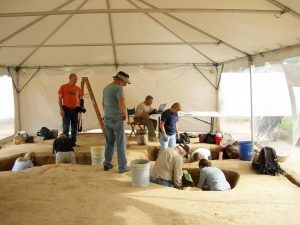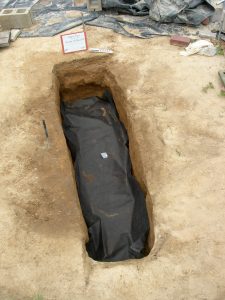Archaeological Discovery Writes New Chapter in Delaware’s Early Colonial History
Department of State | Historical and Cultural Affairs | Date Posted: Thursday, December 7, 2017
Department of State | Historical and Cultural Affairs | Date Posted: Thursday, December 7, 2017

REHOBOTH – An archaeological study years in the making has revealed a wealth of new information about some of Delaware’s earliest colonial settlers and shed new light on what life would have been like in the region three centuries ago.
The discovery of numerous artifacts as well as 11 well-preserved burial sites dating to the late 1600s fills in gaps in Delaware’s early history, telling the story of the colonists’ physical health, diet, family life, and how they made their living. Three of the burials, one a young child, were determined to be of African descent, constituting the earliest known discovery of remains of enslaved people in Delaware.
 In cooperation with Delaware’s historical community, the state will now collaborate on a major research project to attempt to identify each of the individuals buried at the site. Future plans will be developed to exhibit the findings, possibly to include facial reconstructions based on the skeletal remains.
In cooperation with Delaware’s historical community, the state will now collaborate on a major research project to attempt to identify each of the individuals buried at the site. Future plans will be developed to exhibit the findings, possibly to include facial reconstructions based on the skeletal remains.
“Delaware’s history is rich, fascinating and deeply personal to many of us who call this state home,” said Secretary of State Jeff Bullock. “Discoveries like this help us add new sharpness to our picture of the past, and I’m deeply grateful to the passionate community of historians, scientists and archeologists who have helped bring these new revelations to light.”
The site of the discoveries is Avery’s Rest, a 17th century plantation located in what is now West Rehoboth. The original owner was John Avery, who once served as a judge in nearby Lewes in the period just after the colony transitioned from Dutch to English rule.
“This is a story of the life and death of some of the earliest Europeans and Africans to occupy what is now the state of Delaware,” said Daniel Griffith of the Archeological Society of Delaware. “Their interactions with neighbors, colonial governments and global connections with Europe, Africa, and the British colonies, is revealed to us through archaeology and archival research. The story is even more significant as its telling would not have been possible without the volunteer efforts of many members of the Archaeological Society of Delaware.”
 Designated a historically significant site in the 1970s, Avery’s Rest was slated for development in 2005, which spurred the first round of excavations and surveys at the property by the Archeological Society of Delaware in collaboration with the Delaware Division of Historical and Cultural Affairs. Over the next few years, archeologists continued to work the site and branch out into neighboring parcels, uncovering artifacts and evidence of structures from the original plantation.
Designated a historically significant site in the 1970s, Avery’s Rest was slated for development in 2005, which spurred the first round of excavations and surveys at the property by the Archeological Society of Delaware in collaboration with the Delaware Division of Historical and Cultural Affairs. Over the next few years, archeologists continued to work the site and branch out into neighboring parcels, uncovering artifacts and evidence of structures from the original plantation.
The first burials were discovered in 2012. This triggered a legal process under the state’s Unmarked Human Remains Act, which identified three known descendants of John Avery.
With their consent, the state engaged Dr. Douglas Owsley of the Smithsonian Institution for his expertise in the field of physical anthropology and his well-known work with early colonial settlements at Jamestown, Va. and St. Mary’s City, Md. The remains were excavated and transferred to the Smithsonian for advanced DNA testing under Dr. Owsley’s supervision.
“Avery’s Rest provides a rare opportunity to learn about life in the 17th century, not only through the study of buried objects and structures, but also through analyses of well-preserved human skeletal remains,” said Dr. Owsley, who leads the Division of Physical Anthropology at the Smithsonian National Museum of Natural History. “The bone and burial evidence provides an intriguing, personal look into the life stories of men, women and children on the Delaware frontier, and adds to a growing body of biological data on the varied experiences of colonist and enslaved populations in the Chesapeake region.”
Bone and DNA analysis confirmed that three of the burials were people of African descent and eight were of European descent. Coupled with research from the historical record, Dr. Owsley further determined that the European burials may be the extended family of John Avery and his wife Sarah, including their daughters, sons-in-law and grandchildren. However, genetic markers alone are not sufficient to determine the exact identities of the remains.
“This archeological discovery is truly exciting, and reminds us that the ancestors will always make themselves known to us if we listen. The stories of their sacrifices in life and remembrances in death are truly ‘written in bone’ for us to interpret, understand and honor,” said Dr. Angela Winand, head of the Mitchell Center for African American Heritage and Diversity Programs at the Delaware Historical Society. “Long ago, these individuals formed a community at Avery’s Rest upon which our present and our future as a culturally diverse state rests. I look forward to learning more about this discovery from our partners at ASD and the Smithsonian, and sharing these stories with all of Delaware’s citizens, through the work of the Mitchell Center.”
The remains will stay in the custody of the Smithsonian, where they will assist ongoing work to trace the genetic and anthropological history of the early colonial settlers of the Chesapeake region. Delaware law strictly forbids the public display of human remains.
In Delaware, the Division of Historical and Cultural Affairs will continue to work with the Delaware Historical Society, the Archeological Society of Delaware and others to craft a plan to exhibit the Avery’s Rest findings for the public.
Avery’s Rest – key dates
• 1976 – Site identified by Delaware state archeologists
• 1978 – Site listed in the National Register of Historic Places
• 2005 – Proposed development plan in the area raises concerns from the Delaware Division of Historical and Cultural Affairs
• 2006 – The state obtains landowner permission to survey the site
• 2006-08 – The Archaeological Society of Delaware, with assistance from the Division of Historical and Cultural Affairs, carries out surveys and excavations of the part of the site to be affected by the development
• 2009 – The Archaeological Society of Delaware continues its investigation on adjacent properties
• 2010 – An exhibit on findings is presented at the Rehoboth Historical Society
• 2010-12 – The Archaeological Society of Delaware continues its investigation on adjacent properties
• Sept. 2012 – First burials identified
• Nov. 2012 – In accordance with Delaware law, the Division of Historical and Cultural Affairs publishes a notice of the discovery seeking next-of-kin; three descendants of John Avery come forward
• 2013 – Next-of-kin and property owner consent to excavation and analysis of burials; Archaeological Society of Delaware continues investigation and identifies a total of 11 burials
• Sept. 2014 – Memorandum of Agreement signed by Historical and Cultural Affairs, Smithsonian, Archaeological Society of Delaware, and next-of-kin for Smithsonian excavation of the burials, with Historical and Cultural Affairs oversight; remains are transferred to the Smithsonian.
• March 2017 – Smithsonian confirms the age, gender, and ethnicity of the burials
• Aug. 2017 – Final report completed by the Smithsonian
Related Topics: african american history, archaeology, Delaware history, Rehoboth Beach, smithsonian
Keep up to date by receiving a daily digest email, around noon, of current news release posts from state agencies on news.delaware.gov.
Here you can subscribe to future news updates.
Department of State | Historical and Cultural Affairs | Date Posted: Thursday, December 7, 2017

REHOBOTH – An archaeological study years in the making has revealed a wealth of new information about some of Delaware’s earliest colonial settlers and shed new light on what life would have been like in the region three centuries ago.
The discovery of numerous artifacts as well as 11 well-preserved burial sites dating to the late 1600s fills in gaps in Delaware’s early history, telling the story of the colonists’ physical health, diet, family life, and how they made their living. Three of the burials, one a young child, were determined to be of African descent, constituting the earliest known discovery of remains of enslaved people in Delaware.
 In cooperation with Delaware’s historical community, the state will now collaborate on a major research project to attempt to identify each of the individuals buried at the site. Future plans will be developed to exhibit the findings, possibly to include facial reconstructions based on the skeletal remains.
In cooperation with Delaware’s historical community, the state will now collaborate on a major research project to attempt to identify each of the individuals buried at the site. Future plans will be developed to exhibit the findings, possibly to include facial reconstructions based on the skeletal remains.
“Delaware’s history is rich, fascinating and deeply personal to many of us who call this state home,” said Secretary of State Jeff Bullock. “Discoveries like this help us add new sharpness to our picture of the past, and I’m deeply grateful to the passionate community of historians, scientists and archeologists who have helped bring these new revelations to light.”
The site of the discoveries is Avery’s Rest, a 17th century plantation located in what is now West Rehoboth. The original owner was John Avery, who once served as a judge in nearby Lewes in the period just after the colony transitioned from Dutch to English rule.
“This is a story of the life and death of some of the earliest Europeans and Africans to occupy what is now the state of Delaware,” said Daniel Griffith of the Archeological Society of Delaware. “Their interactions with neighbors, colonial governments and global connections with Europe, Africa, and the British colonies, is revealed to us through archaeology and archival research. The story is even more significant as its telling would not have been possible without the volunteer efforts of many members of the Archaeological Society of Delaware.”
 Designated a historically significant site in the 1970s, Avery’s Rest was slated for development in 2005, which spurred the first round of excavations and surveys at the property by the Archeological Society of Delaware in collaboration with the Delaware Division of Historical and Cultural Affairs. Over the next few years, archeologists continued to work the site and branch out into neighboring parcels, uncovering artifacts and evidence of structures from the original plantation.
Designated a historically significant site in the 1970s, Avery’s Rest was slated for development in 2005, which spurred the first round of excavations and surveys at the property by the Archeological Society of Delaware in collaboration with the Delaware Division of Historical and Cultural Affairs. Over the next few years, archeologists continued to work the site and branch out into neighboring parcels, uncovering artifacts and evidence of structures from the original plantation.
The first burials were discovered in 2012. This triggered a legal process under the state’s Unmarked Human Remains Act, which identified three known descendants of John Avery.
With their consent, the state engaged Dr. Douglas Owsley of the Smithsonian Institution for his expertise in the field of physical anthropology and his well-known work with early colonial settlements at Jamestown, Va. and St. Mary’s City, Md. The remains were excavated and transferred to the Smithsonian for advanced DNA testing under Dr. Owsley’s supervision.
“Avery’s Rest provides a rare opportunity to learn about life in the 17th century, not only through the study of buried objects and structures, but also through analyses of well-preserved human skeletal remains,” said Dr. Owsley, who leads the Division of Physical Anthropology at the Smithsonian National Museum of Natural History. “The bone and burial evidence provides an intriguing, personal look into the life stories of men, women and children on the Delaware frontier, and adds to a growing body of biological data on the varied experiences of colonist and enslaved populations in the Chesapeake region.”
Bone and DNA analysis confirmed that three of the burials were people of African descent and eight were of European descent. Coupled with research from the historical record, Dr. Owsley further determined that the European burials may be the extended family of John Avery and his wife Sarah, including their daughters, sons-in-law and grandchildren. However, genetic markers alone are not sufficient to determine the exact identities of the remains.
“This archeological discovery is truly exciting, and reminds us that the ancestors will always make themselves known to us if we listen. The stories of their sacrifices in life and remembrances in death are truly ‘written in bone’ for us to interpret, understand and honor,” said Dr. Angela Winand, head of the Mitchell Center for African American Heritage and Diversity Programs at the Delaware Historical Society. “Long ago, these individuals formed a community at Avery’s Rest upon which our present and our future as a culturally diverse state rests. I look forward to learning more about this discovery from our partners at ASD and the Smithsonian, and sharing these stories with all of Delaware’s citizens, through the work of the Mitchell Center.”
The remains will stay in the custody of the Smithsonian, where they will assist ongoing work to trace the genetic and anthropological history of the early colonial settlers of the Chesapeake region. Delaware law strictly forbids the public display of human remains.
In Delaware, the Division of Historical and Cultural Affairs will continue to work with the Delaware Historical Society, the Archeological Society of Delaware and others to craft a plan to exhibit the Avery’s Rest findings for the public.
Avery’s Rest – key dates
• 1976 – Site identified by Delaware state archeologists
• 1978 – Site listed in the National Register of Historic Places
• 2005 – Proposed development plan in the area raises concerns from the Delaware Division of Historical and Cultural Affairs
• 2006 – The state obtains landowner permission to survey the site
• 2006-08 – The Archaeological Society of Delaware, with assistance from the Division of Historical and Cultural Affairs, carries out surveys and excavations of the part of the site to be affected by the development
• 2009 – The Archaeological Society of Delaware continues its investigation on adjacent properties
• 2010 – An exhibit on findings is presented at the Rehoboth Historical Society
• 2010-12 – The Archaeological Society of Delaware continues its investigation on adjacent properties
• Sept. 2012 – First burials identified
• Nov. 2012 – In accordance with Delaware law, the Division of Historical and Cultural Affairs publishes a notice of the discovery seeking next-of-kin; three descendants of John Avery come forward
• 2013 – Next-of-kin and property owner consent to excavation and analysis of burials; Archaeological Society of Delaware continues investigation and identifies a total of 11 burials
• Sept. 2014 – Memorandum of Agreement signed by Historical and Cultural Affairs, Smithsonian, Archaeological Society of Delaware, and next-of-kin for Smithsonian excavation of the burials, with Historical and Cultural Affairs oversight; remains are transferred to the Smithsonian.
• March 2017 – Smithsonian confirms the age, gender, and ethnicity of the burials
• Aug. 2017 – Final report completed by the Smithsonian
Related Topics: african american history, archaeology, Delaware history, Rehoboth Beach, smithsonian
Keep up to date by receiving a daily digest email, around noon, of current news release posts from state agencies on news.delaware.gov.
Here you can subscribe to future news updates.